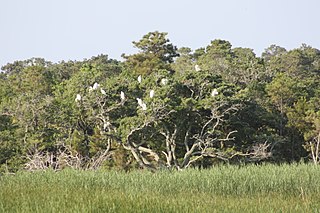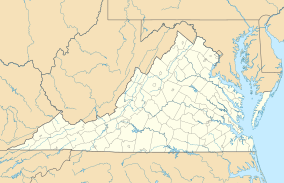
Chestnut Creek Wetlands Natural Area Preserve is a 244-acre (99 ha) Natural Area Preserve located in Floyd County, Virginia. Local wetlands support several rare species, while the upland slopes support northern hardwoods including beech, birch, and maple. The area has a long farming and grazing history, but the wetlands have survived, dominated by sedges and grasses with few trees and shrubs. The property was acquired using a voter-approved state government bond and a recovery grant from the United States Fish and Wildlife Service.

Chub Sandhill Natural Area Preserve is a 1,066-acre (4.31 km2) Natural Area Preserve located in Sussex County, Virginia. It contains a group of low sandhills and riparian wetlands along the Nottoway River. Much of the region's original vegetation has been lost, but the preserve supports such remnants as queen's delight, golden puccoon, and hoary scurf-pea. Sand post oak, rare in Virginia, may also be found in the woods, as may a number of native legumes.

Cleveland Barrens Natural Area Preserve is a 1,288-acre (5.21 km2) Natural Area Preserve located within the Clinch River Valley in Russell County, Virginia.

Dendron Swamp Natural Area Preserve is a 636-acre (257 ha) Natural Area Preserve in Sussex County, Virginia. Located along the Blackwater River, the preserve supports a bald cypress and tupelo swamp. Canopy trees over 98 feet (30 m) tall line the river for two miles (3.2 km), and the swamp shows only occasional signs of logging. Some of the larger cypresses are believed to be over 600 years old. Within the preserve is a nesting site for the great blue heron.

Difficult Creek Natural Area Preserve is an 819-acre (3.31 km2) Natural Area Preserve located in Halifax County, Virginia. The preserve aims to restore a portion of Virginia's southern Piedmont to pre-settlement conditions, when the region was dominated by savannas maintained through a natural fire regime. These savannas featured open, prairie-like areas with scattered pines and hardwoods. Management of the preserve includes utilizing prescribed burns and removing loblolly pine plantations to restore the former landscape. Several rare plants, remnants of the original prairie vegetation, survived by colonizing roadsides and power lines; these plants are now protected and encouraged within the preserve.

False Cape Natural Area Preserve is a 3,573-acre (14.46 km2) Natural Area Preserve located in Virginia Beach, Virginia, just north of the state border with North Carolina. The preserve covers a one-by-six-mile strip of largely undeveloped land located on False Cape between the Atlantic Ocean and Back Bay, and is one of the most undisturbed areas of coastal habitat remaining in the Mid-Atlantic.

Grafton Ponds Natural Area Preserve is a 375-acre (1.52 km2) Natural Area Preserve located in York County, Virginia. It preserves Virginia's best remaining example of a coastal plain pond complex, and supports several locally-rare species including pond spice, Mabee's salamander, barking treefrog, and the globally imperiled Harper's fimbristylis.

Grassy Hill Natural Area Preserve is a 1,440-acre (5.8 km2) Natural Area Preserve located in Franklin County, Virginia, just to the west of the town of Rocky Mount. The site is composed of rocky slopes with various hardwood species and patches of Virginia pine. Shallow basic soils, typified by heavy clay, are found among bedrock outcrops rich in magnesium. Rare woodland communities live upon these substrates, and numerous rare plants may be found within grassy forest clearings near the summit. Evidence at the preserve suggests that the majority of the site was once more open, and may have historically been maintained through a natural fire regime that has been suppressed during modern times.

Hickory Hollow Natural Area Preserve is a 254-acre (1.03 km2) Natural Area Preserve located in Lancaster County, Virginia. The preserve's mixed pine-hardwood forests, ravines, and swampland form a habitat for various songbirds, wild turkeys, and a rare species of plant. The swamp is an example of a globally rare natural community known as a "coastal plain basic seepage swamp", and supports a high level of biological diversity.

Hughlett Point Natural Area Preserve is a 204-acre (0.83 km2) Natural Area Preserve located in Northumberland County, Virginia. It preserves various types of habitat, including tidal and non-tidal wetlands, undeveloped beaches, dunes, and upland forests. Among the species living on the property is the northeastern beach tiger beetle, as well as other rare invertebrates. Hughlett Point is also an important staging area for various species of migrating bird.

Magothy Bay Natural Area Preserve is a 286-acre (1.16 km2) Natural Area Preserve located in Northampton County, Virginia. The preserve encompasses woodlands, wetlands, and salt marshes, providing foraging areas for various species of waterfowl, shorebirds, and wading birds. Diamondback terrapins and clapper rails are frequent visitors, as are many varieties of songbird.

Mark's and Jack's Island Natural Area Preserve is a 2,000-acre (8.1 km2) Natural Area Preserve located in Accomack County, Virginia. The preserve supports Chesapeake Bay beach habitat, as well as various types of marsh, shrub, and forest vegetation. Many species of birds can be found in the preserve's wetlands, and numerous plant species live in the marsh, including marsh-elder. Loblolly pine and black cherry may be seen along the tops of some old dunes. The beaches provide a home for the northeastern beach tiger beetle.

Mount Joy Pond Natural Area Preserve is a 274-acre (1.11 km2) Natural Area Preserve located in Augusta County, Virginia in the United States. Located on the western side of the Blue Ridge Mountains, it supports a large population of the rare Virginia sneezeweed. This and other plants are associated with a large sinkhole pond, the centerpiece of the property; fewer than two dozen such ponds remain in Augusta and neighboring Rockingham County. Much of the surrounding landscape consists of hardwoods and pines.

North Landing River Natural Area Preserve is a 3,441-acre (13.93 km2) Natural Area Preserve located in Virginia Beach, Virginia, United States. It almost entirely consists of wetlands, including five wetland types considered rare in the Commonwealth of Virginia. The preserve protects pocosins, an increasingly scarce type of wetland in the southeastern United States; also in the area are a number of forested swamps and freshwater tidal marshes, all found along the lower North Landing River and supporting numerous rare species. Breeding and wintering waterfowl also make their home in the area.

Ogdens Cave Natural Area Preserve is a 131-acre (53 ha) Natural Area Preserve located in Frederick County, Virginia. The preserve protects a cave that carries a below-ground branch of Buffalo Marsh Run, which also flows overland through the preserve.

Parkers Marsh Natural Area Preserve is a 759-acre (307 ha) Natural Area Preserve located in Accomack County, Virginia. The preserve incorporates beach habitat along the Chesapeake Bay as well as low marsh, high marsh, shrubland, and forest vegetation; the wetlands provide a home for many different species of animals and plants. About 75% of the site is saltmarsh. Marsh elder and black cherry may be found on old dune ridges on the site, as may loblolly pine. Some lower dunes support various grassland species. Peregrine falcons have nested in the area since 1998, and the rare saltmarsh sparrow has been observed nesting at the site. In addition, the beach provides a home for the northeastern beach tiger beetle, listed as threatened in the United States.

Pedlar Hills Glades Natural Area Preserve is a 1,036-acre (4.19 km2) Natural Area Preserve located in Montgomery County, Virginia. Rising over the South Fork of the Roanoke River, it supports numerous rare plants and natural communities, including a dolomite barren. Among the species found within the preserve are tall gay-feather and Addison's leatherflower, the latter endemic to Virginia.

Poor Mountain Natural Area Preserve is a 933-acre (378 ha) Natural Area Preserve located on Poor Mountain in Roanoke County, Virginia. The preserve protects the world's largest population of piratebush, a globally rare parasitic shrub. The mountain derives its name from the fact that the soils on its slopes are poor, due to their base of metamorphosed sandstone bedrock. The preserve's pine-oak/heath woodlands include Table Mountain pine, eastern hemlock, several species of oak, and shrubs including huckleberry, mountain laurel, and fetterbush.

Redrock Mountain Natural Area Preserve is a 640-acre (260 ha) Natural Area Preserve located in Smyth County, Virginia. The preserve is named for the 4,413-foot (1,345 m) Redrock Mountain, which itself is named for its red siltstone cliffs. It supports a number of rare natural features, and two natural community types, including examples of "mountain/piedmont basic woodlands" upon the mountain's slopes, and "rich cove/slope forests" in the preserve's lowlands. Five rare plant species are found on the property, including spring blue-eyed Mary, fringed scorpion-weed, and Carey saxifrage.







